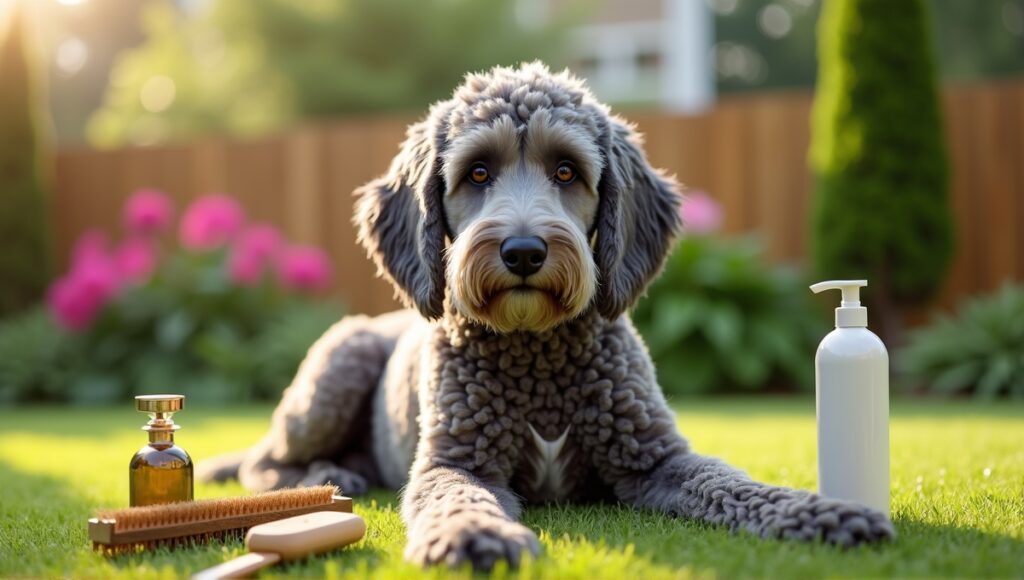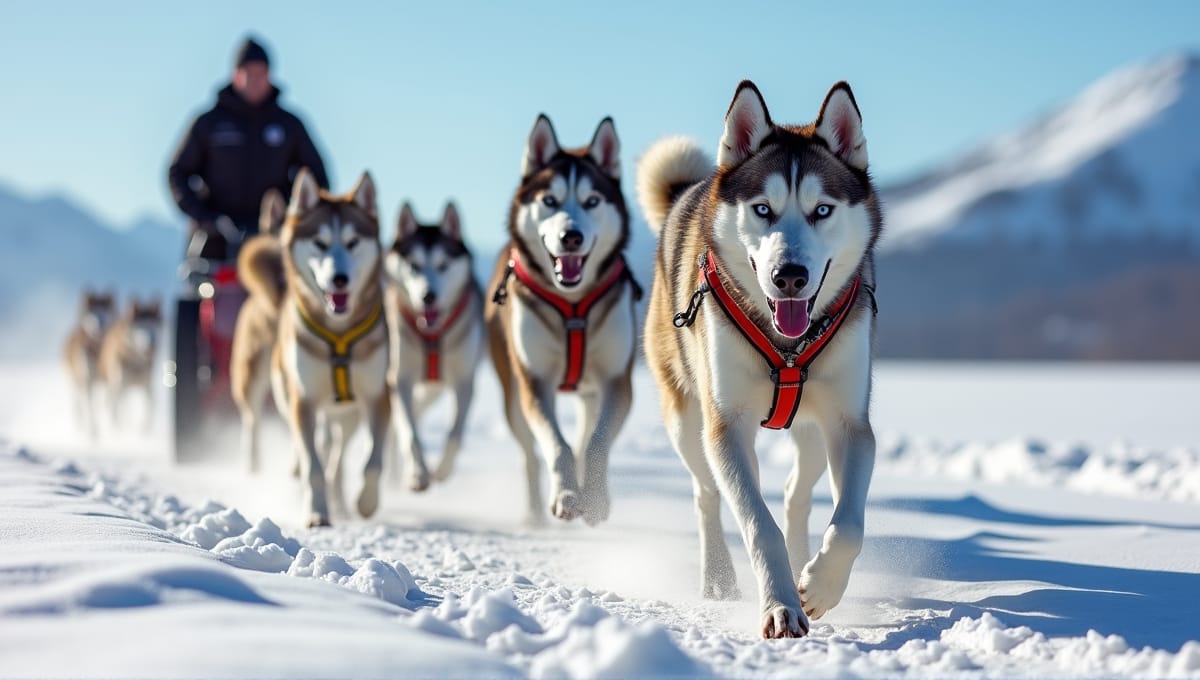As a dog expert and someone who has been around dogs of all shapes and sizes since childhood, I understand the challenge of selecting the ideal animal when you’re concerned about allergies. Large hypoallergenic dogs are an excellent compromise for people with allergies who want a larger breed.
These dogs are larger in size and produce fewer allergens. You’ll learn which breeds are a good fit for your lifestyle and how to handle any allergic reactions. So, let’s discuss your options for a large hypoallergenic dog.
Exploring Sizable Canines with Low Allergen Potential

Large hypoallergenic dogs do exist and are excellent options for people with allergies. So what makes a dog hypoallergenic? It’s not what you might expect.
Contrary to popular belief, no dog is truly hypoallergenic. Instead, the term hypoallergenic refers to dogs that produce fewer allergens. This usually means the dog sheds less and has a coat that retains dander more effectively.
Let’s dispel some common myths about hypoallergenic dogs:
- They don’t produce any allergens.
- Only small dogs can be hypoallergenic.
- They don’t require any grooming.
The reality is that all hypoallergenic dogs do produce some allergens.
Dogs produce several allergens. This includes dander (dead skin cells), saliva, and urine. Dander is the primary allergen that affects most people.
There are some unique advantages to selecting a large hypoallergenic breed. You get the size and power of a large dog with less allergen production. As a result, you can enjoy a protective dog that’s less likely to make you sneeze.
I’ve witnessed these dogs transform people’s lives. One family thought they’d never be able to have a dog because someone in their family was allergic to them. Then, they discovered the Standard Poodle.
Keep in mind that each person’s allergies are different, so you should always spend time with a breed before you take it home with you.
Top Large Hypoallergenic Dog Breeds

Here are some of the best large hypoallergenic dog breeds. Each has its own special characteristics and appeal.
Standard Poodle:
- Very intelligent and easy to train
- Beautiful appearance
- Great for families
- Requires regular grooming
Giant Schnauzer:
- Very loyal and protective
- Excellent work ethic
- Requires lots of exercise
- Beard and eyebrows require some special care
Afghan Hound:
- Very elegant and aloof
- Very independent
- Long, flowing coat
- High grooming requirements
Airedale Terrier:
- Energetic and fun
- Great with kids
- Wiry, low-shedding coat
- Requires lots of exercise
Portuguese Water Dog:
- Very affectionate and outgoing
- Loves water sports
- Curly, non-shedding coat
- Requires regular grooming
Soft Coated Wheaten Terrier:
- Very sweet and mild-mannered
- Great for novice owners
- Soft, silky coat
- Requires regular brushing to avoid matting
Each of these breeds has its own quirks and personality traits. For example, one of my favorite hypoallergenic dogs is the Standard Poodle. They’re extremely intelligent and can easily be trained to adapt to your lifestyle.
If you want to learn more about large poodle breeds, check out our guide on large poodle breeds.
Characteristics of Large Hypoallergenic Dogs
Large hypoallergenic dogs come in all shapes and sizes. Here are the key characteristics of each:
- Size and Weight: These dogs are typically 50 to 100 pounds, though some, like the Giant Schnauzer, can be even larger.
- Coat Types: Most of these dogs have curly, wiry, or silky coats. These coat types effectively trap dander.
- Exercise Needs: Most large hypoallergenic breeds are active dogs that need plenty of exercise.
- Temperament: Most of these dogs are intelligent and friendly. Many were bred to work, so they tend to be very eager to please.
Here’s a quick overview of these traits for each breed:
| Breed | Size (inches) | Weight (lbs) | Coat Type | Exercise Needs | Temperament |
|---|---|---|---|---|---|
| Standard Poodle | 18-24 | 45-70 | Curly | High | Intelligent, Playful |
| Giant Schnauzer | 23-28 | 55-85 | Wiry | Very High | Loyal, Protective |
| Afghan Hound | 25-27 | 50-60 | Silky | Moderate | Independent, Dignified |
| Airedale Terrier | 22-24 | 50-70 | Wiry | High | Energetic, Confident |
| Portuguese Water Dog | 20-23 | 35-60 | Curly/Wavy | High | Affectionate, Adventurous |
Keep in mind that these are generalizations, and each dog is an individual.
Care Requirements for Large Hypoallergenic Dogs

Caring for a large hypoallergenic dog is a big commitment. Here’s a breakdown of what you need to know:
- Grooming is a must. Most of these breeds require brushing several times per week, and breeds like the Poodle need professional grooming every 6-8 weeks. Regular grooming helps manage allergens and maintain a healthy coat.
- Exercise is a requirement. Many of these breeds are quite active. A daily walk won’t cut it. They need at least an hour of intense exercise each day, whether that’s running, swimming, or playing fetch.
- Diet is also important. Large breeds have different nutritional requirements, and they need a quality, balanced diet high in protein and other nutrients to support their size and energy levels. As always, consult a vet about the best diet for your specific breed.
- Health considerations include the fact that larger hypoallergenic breeds are more prone to specific health issues. For example, hip dysplasia is common in larger dogs, and certain breeds like the Standard Poodle may be at risk for bloat. Regular vet check-ups are a must.
- Training and socialization should begin as early as possible. These are intelligent breeds that need mental stimulation, and positive reinforcement training works best. Early socialization prevents behavior problems later on.
In my experience, the effort you invest in caring for these breeds is repaid tenfold through their companionship and loyalty.
Controlling Allergies with Big Allergy-Friendly Canines
Even with hypoallergenic dog breeds, managing allergies still takes effort. Here are some strategies that have personally worked well for me:
- Groom your dog outside of your home as much as possible.
- Use HEPA air purifiers in your main living spaces.
- Vacuum your carpets and furniture with a HEPA filter vacuum cleaner frequently.
- In general, wash your hands after petting your dog.
- Make your bedroom off limits to your dog.
Bathing your dog every 1-2 weeks significantly reduces allergens. It is also important to use a gentle, dog-specific shampoo to avoid irritating your dog’s skin.
Air purification is another important step. High-quality air purifiers do an excellent job of removing airborne allergens. Place these in the rooms where you and your dog spend the most time.
Regular cleaning is also important. Try to vacuum at least twice a week. Similarly, don’t forget to clean curtains and wash your pet’s bedding regularly.
Getting advice from professionals can also be helpful. An allergist can provide advice for managing your symptoms. A veterinarian will be able to tell you how to reduce allergens that are specific to your dog.
Keep in mind that everyone has different allergy sensitivities, so what works well for one person may not work well for another person. Therefore, be patient and be willing to adjust your strategy to eliminate allergens as needed.
Pros and Cons of Owning Large Hypoallergenic Dogs
There are a few pros and cons to owning a large hypoallergenic dog:
Pros:
- Many people experience fewer allergy symptoms
- Often do not shed much, meaning you won’t have to clean as often
- Generally very smart and easy to train
- Can offer protection because of their size
- Excellent companions for active people
Cons:
- More grooming and potential grooming expenses
- Need more space because of their size
- May have higher exercise needs
- More expensive to feed and take care of
- Not suitable for small living spaces
These dogs are best for active people or families with plenty of space. They’re great for people who like outdoor activities and can commit to grooming and daily exercise.
However, they’re not a great fit for apartment owners or people with little time for grooming. So, think about your lifestyle before selecting a large hypoallergenic dog breed.
In my experience with dogs, I’ve seen these breeds become very happy and loyal dogs when placed in the right environment.
Final Takeaways
Large hypoallergenic dogs are a great compromise of size and allergen reduction. They’re the ideal solution for people with allergies who want a larger dog. These breeds require regular grooming and exercise, but in return, you’ll receive a loyal, loving dog. Keep in mind that every dog is an individual. What I recommend may not work for another dog.
I’ve witnessed the impact these dogs can have on people’s lives. They allow allergy sufferers to finally experience the joy of owning a dog without sneezing constantly. However, they’re not a cure-all. You’ll still have to manage your allergies and provide proper care.
Choose carefully, and you’ll have a large, loving companion that doesn’t make you sneeze.






